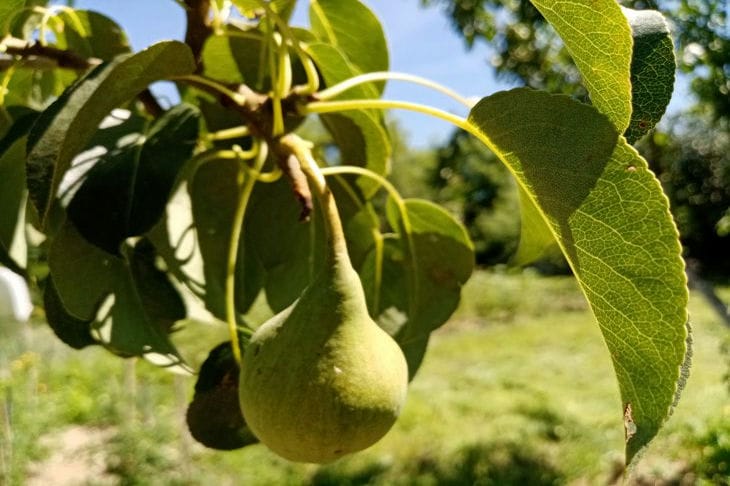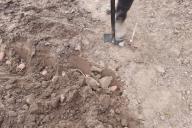Determining a suitable location for planting a pear tree on a plot is an essential step that directly affects the health and productivity of the tree.
Many gardeners face a problem when, despite proper care, the pear tree does not produce the expected fruits or is susceptible to disease.
The main reason for these difficulties is the poor choice of landing site.
Anastasia Kovrizhnykh explains how to choose the best place for a pear tree on your plot, taking into account all the important aspects.
The Importance of the Right Place to Plant a Pear Tree
The right place to plant a pear is the key to its successful growth and fruiting. A pear, like any other fruit tree, requires certain conditions for normal development.

Inappropriate conditions can result in poor growth, disease, and low yields, so it's important to consider several key factors when choosing where to plant your pear tree.
Lighting and wind protection
Pears prefer sunny areas with sufficient light throughout the day.
Insufficient light negatively affects photosynthesis, resulting in poor growth and poor yields. It is important to choose a site that receives at least 6-8 hours of sunlight per day.
In addition, pears are sensitive to strong winds, especially cold northern and eastern ones.
Winds can damage flowers and young shoots, reduce yields and cause damage to the tree.
It is recommended to choose areas protected from the wind, for example, located next to a fence or other buildings that can serve as natural protection.
Soil type and preparation
Pears prefer fertile, well-drained soils with a neutral or slightly acidic reaction.
Clay and heavy soils that retain water can cause root rot and tree death. It is recommended to conduct a soil analysis before planting to determine its composition and reaction.
If the soil does not meet requirements, you can make necessary amendments, such as adding sand to improve drainage or lime to neutralize the acid.
Soil preparation involves deep digging of the area and the addition of organic fertilizers such as humus or compost.
This will provide sufficient nutrients and improve the soil structure, which will promote the development of a strong root system and healthy growth of the pear tree.
Groundwater level and drainage
The groundwater level is an important factor to consider when choosing a location for planting a pear tree.
Pears do not tolerate stagnant water, so the site must have good drainage. High groundwater levels can lead to root rot and the death of the tree.
The optimal level of groundwater is no higher than 1.5-2 meters from the surface. If the groundwater level on the site is high, it is recommended to use drainage systems or plant the pear on elevated beds.
Distance to other trees and buildings
For normal development and fruiting of the pear, it is necessary to take into account the distance to other trees and buildings.
The pear has a branched root system and a spreading crown, so it needs enough space to grow. It is recommended to plant the pear at a distance of at least 4-5 meters from other trees and buildings.
This will ensure sufficient light and nutrients, and prevent competition for resources. In addition, maintaining the required distance helps to avoid crown thickening, which improves ventilation and reduces the risk of diseases.
Climatic conditions and microclimate of the site
The climate conditions of the region play a key role in choosing a place to plant a pear. Pears are sensitive to extreme temperatures and frosts.
It is important to take into account the climate characteristics of your region and choose varieties adapted to local conditions.
The microclimate of the site is influenced by factors such as relief, the presence of water bodies and other objects.
Plots with southern exposure, protected from northern winds and located on slopes have a more favorable microclimate for planting pears. Such conditions contribute to faster warming of the soil and air in the spring, which accelerates the onset of vegetation and reduces the risk of frost damage to the tree.
Water supply and irrigation
Pears require regular and sufficient watering, especially during the period of active growth and fruiting. Lack of moisture can lead to weak growth, reduced fruit size and reduced quality. It is important to ensure a constant water supply and the possibility of regular watering.
It is recommended to choose areas that have access to water sources or are equipped with irrigation systems.
It is optimal to use drip irrigation, which ensures uniform soil moisture and reduces the risk of water stagnation. It is also important to consider the pear's water needs depending on the growth phase and climatic conditions.
Fertilizers and feeding
For full growth and development of pear, regular fertilization is necessary.
Pear needs macro- and microelements such as nitrogen, phosphorus, potassium, magnesium and iron. Lack of nutrients can lead to poor growth, leaf chlorosis and reduced yield.
Before you start planting a pear tree, it is advisable to add organic fertilizers, such as compost or humus.
This will enrich the soil with the necessary nutrients and improve its structure. In the future, regular fertilizing should be carried out throughout the growing season, taking into account the needs of the tree at different stages of growth.
Peculiarities of caring for a pear after planting
After planting a pear, it is important to provide proper care, which includes watering, fertilizing, pruning, and protection from pests and diseases.
In the first year after planting, the main attention should be paid to watering and crown formation. Regular watering is necessary for rooting and active growth of the tree. Formative pruning helps to create the correct crown shape and improve lighting of all parts of the tree.
In the second and subsequent years, it is necessary to continue regular care, including watering, fertilizing and pruning.
Particular attention should be paid to protecting the pear from pests and diseases. The use of preventive measures and timely treatment help maintain the health of the tree and obtain a high yield of quality fruits.
Earlier we listed 4 reasons why cherry trees bloom but do not bear fruit.









